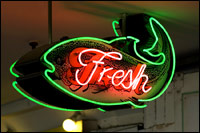Tuesday, 31 Jan 2006
Seattle, Wash.

Seattle is for fish-lovers.
Photo: iStockphoto.
This week, 235 hardy soles braved the rains of Seattle to attend the 2006 Seafood Summit, a gathering of sustainable-seafood advocates. On Sunday, at a reception that transformed the city’s aquarium into an otherworldly nightclub, they sampled West Coast delicacies, schmoozed with each other, and learned how to pronounce the name of the Northwest’s notorious giant clam, the geoduck (that would be “gooeyduck”). They spent the next two days at a waterfront hotel, chewing over topics from certification to carnivorous finfish aquaculture. Such a prospect no doubt brings untold questions to mind, so I’ll do my best to answer them.
Why are you making me read a story about a conference?
That’s an excellent question. It would have to be because I had the chance to eat free food, and because it wasn’t far from the office. Also, of course, because environmentalism is about more than just land, and sustainable fisheries are an issue deserving our attention. After all, you can’t talk peak oil all the time.
Well, OK. So who was there — and why?
For the first time in the five-year history of the summit — initially created by the Seafood Choices Alliance as a conservation-community brainstorming session — the crowd was evenly split between corporate types and enviros (with a few foundation reps sprinkled in). They came from all over the world to attend a meeting that has become, to poorly paraphrase SCA’s communications associate, “a venue for partnerships and synergies between business and conservation.”
What kind of partnerships and synergies did you see?
Well, there was that really tall guy checking out the octopus tank.
Was there any news to be had at this thing?
Yes, there was. The crowd was all abuzz about the fresh announcement that Wal-Mart will start selling eco-certified fish. The mega-retailer will stock its coolers with the help of the Marine Stewardship Council, which certifies fisheries around the world, and will also partner with Conservation International and the World Wildlife Fund to help non-certified suppliers get up to snuff. In short, huge news on the fish front.
Sounds like corporate greenwashing.
It’s not.
How do you know?
Because Rupert Howes, the CEO of MSC, told me so.
What else did Rupert Howes tell you?
That he was incredibly jet-lagged, that it was 4:30 a.m. in England, and that he hadn’t had a bite to eat all night.
Speaking of eating — how was that free food?
Darn good. Several West Coast suppliers donated products that Seattle-area chefs whipped up into astonishing appetizers. There was the geoduck sashimi, which tasted about like you’d expect a raw slice of gigantic clam to taste (hooray for wasabi). Then there was the Washington oyster bar, manned in part by a fourth-generation oysterman gleefully explaining the aphrodisiacal effects of his wares. There were mussels in lime-tequila sauce, clams with chorizo sausage, and a mind-boggling, Iron Chef-worthy snack of potato galettes topped with smoked sturgeon, quail egg, crème fraîche, and caviar. Then, of course, there was the chicken.
Chicken?
Oh yeah. Servers wandered through the entire time with trays of the stuff (um, paging Jessica Simpson). I asked one of them if people were eating much of it, and she said yes, it was her third tray — then made me try a piece. When I asked the chef responsible for the caviar concoction what he thought of the decision to serve fowl, he laughed and said it was odd. “But it’s tasty,” he admitted.
So it sounds like you consumed, what, 16.6 pounds of seafood?
I didn’t, but it’s funny you should toss that number out. That’s the average amount of seafood Americans ate in 2004, according to the National Oceanic and Atmospheric Administration.
Which would add up to about …
Yup, 4.8 billion pounds, a record-setter. It’s no wonder there’s concern about cleaning out the oceans. Sustainable seafood advocates worry about overfishing and disease, about the damage to ocean health caused by practices like bottom trawling, about mercury and other pollutants, about the role of aquaculture, and about getting the word out to consumers.
A lot of worrying goes on, actually, but there’s hope too. As one WWF presenter put it, the movement really is progressing toward “those four magic words: safe, legal, accountable, and sustainable.” I think she forgot tasty, but you get the idea.
Speaking of forgetting things, which George Bush malapropism best applies to this event?
That would have to be, as quoted by SeaWeb’s Dawn Martin, “I know the human being and fish can coexist peacefully.” When Martin said this, I nodded sagely, but it was only as I listened to another woman nearby that its delicious irony hit. That woman was slicing into a thick, wet geoduck with a cleaver, proclaiming that the monstrous bivalve was “so fresh it was alive at 3 o’clock this afternoon.” The best thing about sustainable-seafood advocates and their peaceful coexistence? When all is said and done — and done well — they just want to chow down.


